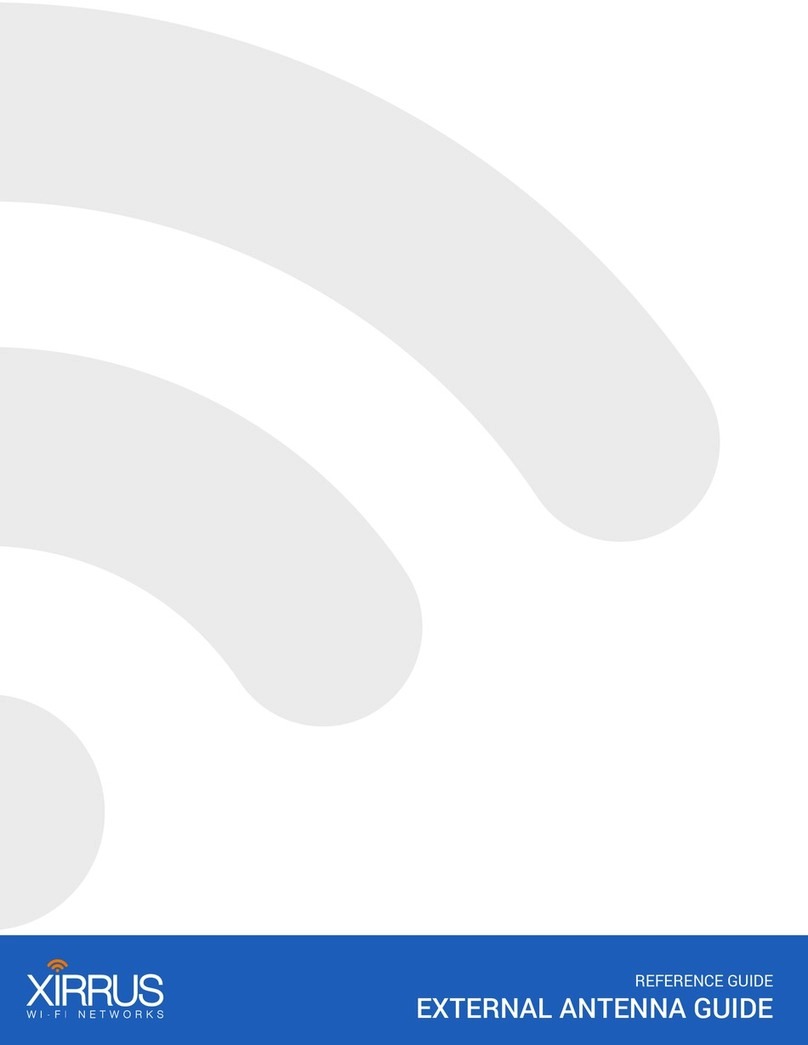Overview
To optimize the overall performance of a Xirrus WLAN in an outdoor
deployment it is important to understand how to maximize coverage with the
appropriate antenna selection and placement. This document is meant to serve
as a guideline for anyone who wishes to use Xirrus’ antennas and related
accessories with Xirrus’ outdoor wireless products (XR-520H, XR-2425H, and
XH2-120). The document is organized according to the following
sub-sections:
• Basic Technical Background
• Types of available Xirrus Antennas and Accessories
• Design Considerations and Reference Use Cases
Technical Background
ISM bands:
The U.S. Federal Communications Commission (FCC) authorizes commercial
wireless network products to operate in the Industrial, Scientic and Medical
(ISM) bands using spread spectrum modulation. The ISM bands are located at
three different frequencies ranges – 900MHz, 2.4GHz and 5GHz. This
document covers products that operate in the 2.4 and 5GHz bands.
ISM bands allow manufacturers and users to operate wireless products in the
U.S. without requiring specic licenses. This requirement may vary in other
countries. The products themselves must meet certain requirements in order
to be certied for sale such as maximum Transmit Power (Tx Power) and
Effective Isotropic Radiated Power (EIRP) ratings.
Each of the ISM bands has different characteristics. The lower frequency bands
exhibit better range but with limited bandwidth and hence lower data rates.
Higher frequency bands have less range and are subject to greater attenuation
from solid objects.
Antenna Properties, Ratings and Representation
At the most fundamental level an Antenna provides a wireless communication
system three main attributes that are inter-related to each other and
ultimately inuence the overall radiation pattern produced by the antenna:
• Gain
• Directivity
• Polarization
Gain of an Antenna is a measure of the increase in power that the antenna
provides. Antenna gain is measured in decibels (dB) — a logarithmic unit used
to express the ratio between two values of a given physical quantity. In the
general case, the gain in dB is a factor of the ratio of output power (or radiated
power) to the input power of the antenna (that ratio is also called the
“efciency” of the antenna). In practice, the gain of a given antenna is
commonly expressed by comparing it to the gain of an isotropic antenna. An
isotropic antenna is a “theoretical antenna” with a perfectly uniform
three-dimensional radiation pattern. When expressed relative to an isotropic
antenna, the gain of a given antenna is represented in dBi (i for isotropic). By
that measure, a truly isotropic antenna would have a power rating of 0 dB. The
U.S. FCC uses dBi in its calculations.
Directivity is the factor that was referred to in the previous discussion about
antenna gain and its relation to efciency. Mathematically, the gain of an
antenna is its directivity times its efciency. And like its gain, the directivity of a
given antenna is also expressed relative to an isotropic antenna. The directivity
measures the power density that an antenna radiates in the direction of its
strongest emission, relative to the power density radiated by an ideal isotropic
antenna (which emits uniformly in all directions), when they are both radiating
the same total power.
Polarization of an antenna is the orientation of the electric eld of the radio
wave that it produces relative to the earth’s surface. The polarization of an
antenna is determined by the physical structure of the antenna and by its
Xirrus External Antennas Guide




























